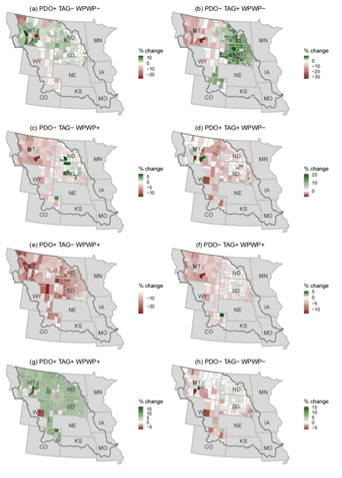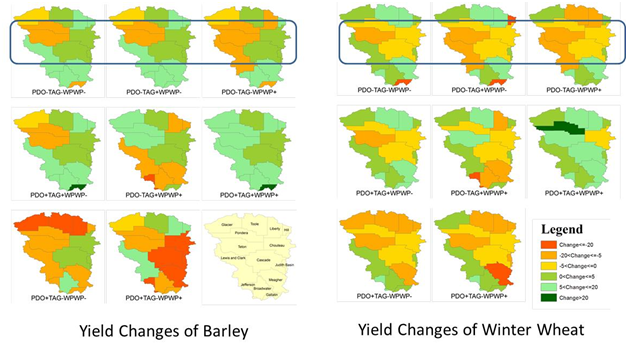Impacts of Decadal Droughts on the Agricultural Economy of the Missouri River Basin
Funded by:
National Oceanic and Atmospheric Administration – Climate Program Office – Sectoral Applications Research Program; Sept. 2012 – August 2014
Principal Investigator:
Vikram Mehta, CRCES
Research Associate:
Katherin Mendoza, CRCES
Co-Investigators:
Norman Rosenberg, CRCES
Bruce McCarl, Texas A & M University, College Station Texas
Raghavan Srinivasan, Texas A & M University, College Station, Texas
Arun Kumar, NOAA – Climate Prediction Center, Camps Springs, Maryland
Proposal Summary
We propose to estimate impacts of three major decadal climate variability (DCV) phenomena — the Pacific Decadal Oscillation (PDO), the tropical Atlantic sea-surface temperature (SST) gradient oscillation (TAG for brevity), and the west Pacific Warm Pool variability (WPWP for brevity) — on the agricultural economy of the Missouri River Basin (the Basin hereafter). Our previous research has shown that these DCV phenomena substantially impact water and crop yields in the Basin, and that impacts of interannual climate variability and potential climate change on the agricultural economy are amenable to rigorous analysis. Therefore, building on our previous work (and that of others), the scientific objectives of the proposed research are (i) to estimate first-order and indirect impacts of DCV on the agricultural economy of the Basin; (ii) to assess the potential economic value of advance information on the occurrence of DCV events; and (iii) to identify a set of ‘best management practices’ for adapting agriculture in the Basin to DCV. We will use a variety of hydro-meteorological, climatic, agricultural, water, and economic data in this research. The well-established Soil and Water Analysis Tool (SWAT) and Forest and Agricultural Sector Optimization Model (FASOM) will be employed in the proposed research. The adaptation strategies to be developed in this project will be useful to society in maximizing benefits and minimizing adverse impacts of decadal droughts or wet epochs associated with the DCV phenomena. Results of the proposed research may also be useful in defining the need for investments in DCV observation and prediction systems.
Results will be published in peer-reviewed scientific journals such as the Journal of Agricultural and Resource Economics, Journal of the American Water Resources Association, and Bulletin of the American Meteorological Society. Articles will also be published in appropriate newsletters. Presentations will be made at national and regional conferences and at specialty conferences. We will also provide briefings to stakeholders, NOAA program managers and NOAA climate service scientists in the Basin and elsewhere. In addition to the dissemination channels outlined above, the results and recommendations emanating from our study will also be placed on appropriate Web sites. Combining results of this project and experiences of this multidisciplinary project team, we will prepare a guidebook for the assessment of economic impacts of DCV and the development of adaptation strategies in the Basin and elsewhere.
The proposed research is consistent with the FY2012 SARP emphasis on “Coping with droughts and NIDIS” and the specific objective of assessing impacts including indirect or secondary economic impacts in the Great Plains region-a large portion of which is located in the Basin. The proposed project may provide a geographically-focused effort for a future NIDIS pilot project. Also, the proposed research is highly relevant to NOAA’s long-term goal of developing climate adaptation and mitigation strategies as described in NOAA’s Next-Generation Strategic Plan.
Project Summary
The scientific objectives of the research were:
- To estimate first-order and indirect impacts of decadal climate variability (DCV) on the agricultural economy of the Basin;
- To assess the potential economic value of advance information on the occurrence of DCV events; and
- To identify a set of ‘best management practices’ for adapting agriculture in the Basin to DCV
First-order Estimation of Decadal Climate Variability Impacts on Economic Value of Crop Production
There is economic value in DCV information because decision makers would likely make adjustments for revised expectations of yields and water supply if they have DCV information in advance. If farmers knew in advenca that water demands would be higher and supplies smaller, they might plant a smaller area. If they knew some crop yields would be lower and others higher, they might shift their crop mix. If water planners knew water would be in short supply, they might encourage conservation, reduce use, and negotiate options to buy out some agricultural water rights. These and other actions compared to actions based on the climatic record would generate value. Fernandez (2013) and Fernandez et al. (2016) used the agriculture and water choices model RIVERSIM to make a first-order estimation of the economic value of DCV information in the MRB. Sixteen crops in 411 counties in MRB; agricultural irrigation and dryland farming; hydrological flow balance; reservoir storage; and municipal and industrial water use were included to estimate DCV impacts on wheat (spring and winter), corn, sorghum, and soybeans. Uncertainty about which combination of phases of major DCV phenomena will occur in the next one year and crop insurance were included in the estimation process.
We incorporate information on the impacts of the combined occurrence of the positive (+) and negative (-) phases of three DCV phenomena: the Pacific Decadal Oscillation (PDO), the Tropical Atlantic Gradient (TAG), and the West Pacific Warm Pool (WPWP) on crop yields using estimates from the SWAT model generated by the other project components.
We consider three possible information settings for the DCV.
The first type is the naïve DCV information case, in which the likelihood of 8 DCV phase combinations is based on the historical frequency-based probability distribution of historical events. A farmer maximizes profits in a stochastic problem setting, setting crop mix and irrigation extent taking into account the historical distribution of 8 possible DCV phase combinations.
The second type gives the conditional distribution forecasting next years’ DCV phase combination given this years’ DCV phase combination. This reduces climate and yield uncertainty faced by decision makers, since DCV information conditional on the todays phase combination narrows down the possible DCV phase combinations for next year and allows adaptation in the form of a customized crop mix and irrigation plan.
The third type assumes we can tell several months in advance exactly what next year’s phase combination will be in a perfect information setting.
We use a stochastic programming model that simulates profit maximizing crop mix and irrigation under the three DCV information settings. We compare the gains to the conditional and perfect information relative to the naïve case.
The results show that:
- Conditional DCV information generates net benefits of $28.84 million dollars per year for the MRB annually.
- Perfect information results in a net benefit of $82.30 million.
- There are profitable adaptations on a regional basis that are shifts in crop mix and extent of irrigation that vary across the DCV information forms.
Econometric Analysis of DCV Effects on Crop Yields in the MRB
Huang (2015) used hierarchical linear mixed effect models in a Bayesian framework to
Capture county varying DCV impacts on crop yields; and
Prevent extreme estimates for counties with small number of observations.
The study was carried out for eight major crops (barley, corn, alfalfa hay, oats, sorghum, soybeans, spring wheat and winter wheat ) for all counties in the Missouri River Basin. The model was a 2-stage model that first estimated DCV effects on climate and then on crop yields. Positive and negative phases of the PDO, TAG, and WPWP variabilities – a total of eight phase combinations – were included in this study. The items for which DCV effects on climate were analyzed were monthly mean temperature, total precipitation, number of days with maximum temperature greater than or equal to 90°F, number of days with precipitation greater than or equal to one inch in the summer growing season, and number of days with minimum temperature less than or equal to 0°F over the winter growing season. Crop yields were analyzed using a model that has direct effects of DCV on yields, effects of DCV altered weather on yields using linear and quadratic terms, and effects of time and time-squared to reflect technological progress.
Results show that DCV impacts are spatially heterogeneous across counties and vary with DCV phase combination. For example, Figure 1 shows county level yield effects on spring wheat in each of the eight DCV phase combinations from 1949 to 2011.

Figure 1: Percent change in county-level spring wheat yield in each DCV phase combination compared to long-term average yield in the Missouri River Basin.
Very-high Resolution Simulation of Decadal Climate Variability Impacts on Crop Production and Its Economic Value
A very high resolution (~ 12 km x 12 km) version of the Soil and Water Analysis Tool (SWAT), a hydrology-land use-crop model, has been developed, calibrated, and validated for the MRB (Daggupati et al., 2016). Simulation experiments to estimate impacts of DCV on water resources and yields of major crops in the MRB have been run. It has been found that typical intensities of PDO and TAG can change water and crop yields at individual locations by as much as 40% of the average yield. It has also been found that constructive superposition of phases of the two DCV phenomena can change water and crop yields by as much as 80% of the average yield and destructive superposition can mitigate effects of individual DCV phenomenon (Mehta et al., 2016, 2017). These very high-resolution simulations of DCV impacts on water and agriculture will now be used to extend the Fernandez (2013) and Fernandez et al. (2016) research on the economic value of DCV information to very high spatial resolutions.
- Identification of ‘best management practices’ for adapting agriculture in the MRB to DCV
Ding (2014) explored adaptation options for farmers in the Marias sub-basin in Montana within the MRB. The 11-county Marias sub-basin is an important agricultural region, accounting for a large portion of Montana’s agriculture. Substantial and identifiable DCV signals in precipitation and temperature are found in the Marias basin. Ding (2014) used an econometric method to analyze DCV effects on crop yields and identified potential adaptation options in the sub-basin using crop and other data from 1949 to 2011. The main findings are that there are strong but spatially variable DCV effects on barley, winter wheat, and spring wheat. Varying effects of DCV phase combinations on major crops permit adaptation of crop mix if prior information is available on DCV phases over the next one year. For example, Figure 2 shows county level effects of eight DCV phase combinations on yields of barley and winter wheat in the Marias sub-basin. If next year’s DCV phase combination can be predicted accurately, then Figure 2 can be used to advise farmers to plant winter wheat or barley.

Figure 2: Percent change in county-level barley and winter wheat yield in each DCV phase combination compared to long-term average yield in the Marias sub-basin.